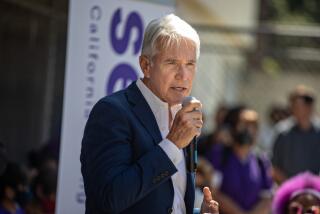This Southern murder trial inspired Harper Lee’s ‘lost’ book. ‘Furious Hours’ reexamines it
It was one of the publishing events of the millennium so far: the publication of Harper Lee’s second book in 2015, more than half a century after “To Kill a Mockingbird.” Actually, though it was set two decades after “Mockingbird,” “Go Set a Watchman” had been written before — it was the manuscript that piqued publishers’ interest in Lee and introduced Atticus Finch to the world. Lee’s intended follow-up to “Mockingbird” was to have staked out bold new ground. Conceived as a work of “In Cold Blood”-like reportage, its subject matter was no less hard-boiled — six corpses, a suspected serial killer rumored to dabble in voodoo, a vigilante who slew him and lawyer who represented both. Yet it was also familiar: an Alabama court case intersected by race — the alleged mass murderer and his avenger were black; their Atticus-like defender white. Moreover, Lee had furnished crucial assistance to her friend Truman Capote in the workup for “In Cold Blood” and gotten within one semester of a law degree before dropping out of college. The project seemed a match of author with subject. But it became an “albatross.” She finally abandoned and, with it, any aspiration to a post-”Mockingbird” second act. In “Furious Hours,” Casey Cep picks up where Lee left off with a full accounting of a shocking true-crime case and the great literary might-have-been it spawned.
The Rev. Willie Maxwell was nothing if not industrious. Besides preaching, he quarried rock and ran a crew clearing timber for paper mills. And in 1970 he allegedly began cutting a swath through his own family tree, cleaning up on life insurance policies he’d taken out on relatives. Over the next seven years, he lost two wives, a brother, nephew and stepdaughter plus the husband of his second wife whose death permitted that marriage (and another payout) — all under highly suspicious circumstances. Yet the police seemed unable to touch him.
“Casey Cep picks up where Lee left off with a full accounting of a shocking true-crime case and the great literary might-have-been it spawned.”
The truth was more prosaic. Authorities were thwarted by evidence that, pre-DNA testing, didn’t quite meet the threshold for making charges stick. That, and a resourceful attorney whose zeal for defending his client was matched only by the alacrity with which he pursued Maxwell’s insurance claims — for which he cut a deal to take half of all he recouped. For ex-Democratic state lawmaker Tom Radney, defending Maxwell was highly remunerative but came at reputational cost. Rehabilitation was at hand though when, at the funeral of Maxwell’s stepdaughter, a relative of the girl, Robert Burns, shot Maxwell dead — Radney lost one client and acquired another.
And Radney was who tipped Lee, an acquaintance, to this real-life Southern Gothic. For Lee it was a literary homecoming. “Mockingbird” wasn’t the book she’d intended as “Watchman” attests. In that germinal work, far from being a “moral exemplar,” Atticus kvetches about the NAACP and integration. It sought to capture an insidious reality wherein upstanding citizens could “defend a black man in court only to bar him from the ballot box…,” writes Cep. “Mockingbird’s” simplification was driven by novelistic exigency; her editor found “Watchman” preachy. But it also pandered to Northerners’ expectations, Cep adds. Later, Lee reprised “Watchman’s” theme in a story commissioned by Esquire about “some white people who were segregationists & at the same time loathed & hated the K.K.K.” It was deemed “an axiomatic impossibility” and spiked.
Here was a real-life case true to her lived experience then that was impregnable to an editor’s incredulity or red pen. And Burns’ trial, for which Lee decamped south, didn’t disappoint: amid fervid legal sparring, Radney’s daring insanity defense prevailed — Burns was consigned to a psychiatric hospital from which within weeks he was discharged. By turning the proceedings into a proxy trial of Maxwell — calling a witness who testified Maxwell attempted to enlist him in a plot to murder his stepdaughter — Radney valorized Burns as an agent of retributive justice. He also expiated his own sins.
But it also trod vexed ground — “moral muddiness concerning black criminality in a criminally racist society.” Then there was Radney, for all his progressivism and civil rights activism a troubling figure, supposed redemption or not. While Maxwell kept his liberty and Radney took him to the bank (locals branded the plush office he built himself, “the Maxwell House”), a black community marked by extended kinship ties was terrorized, wondering who’d be next to suffer one of the accidents or premature deaths that uncannily befell many of Maxwell’s relatives.
It was knotty and dramatically unwieldy, not to mention the “mountain of rumors and…molehill of facts,” as Lee put it. Then there were her scruples; she didn’t hold with the license Capote took to arrange, even invent, facts for a more congenial narrative. She recast her account as fiction, but didn’t get far (unless her “sealed” estate contains a cache of material).
Cep narrates this saga atmospherically and with empathy. There are lyrical passages — Alabama “sits like a headstone between Mississippi and Georgia” — plus judicious detail: police at Maxwell’s funeral scan “men’s blazers to see if they flapped in the wind or stayed still, held down by the weight of a gun.” Excursions into the annals of life insurance fraud and folkways of voodoo are fascinating. Though I wonder if she reckons sufficiently with Radney — an exhibit here of the insouciance toward “black-on-black crime” she otherwise notes.
Ultimately, Cep conjectures, Lee lost “her nerve.” Here, the 17 years since “Mockingbird’s” publication during which she’d been blocked before the trial hardly seem an incidental prologue. Lee’s complaints about the penal tax bracket into which “Mockingbird’s” earnings vaulted her, supposedly proscribing her ability to work, appear to transpose a wider defensive crouch — a sentiment captured in a remark cited in a New York Times review of a 2006 biography: “When you’re at the top, there’s only one way to go.”
In relinquishing the burden of “expectations,” Lee found release. “Somewhere along the line, she stopped doing two things destructive to her own well-being,” writes Cep. “One was drinking; the other was writing.… After three dark decades, her letters become more buoyant — no longer anguished, and absent almost any mention of trying to write.”
“Furious Hours: Murder, Fraud, and the Last Trial of Harper Lee”
Casey Cep
Knopf: 336 pp., $26.95
Phillips’ writing has appeared in the Times Literary Supplement, the Economist, the Wall Street Journal, Atlantic (online), Smithsonian, Washington Monthly, Irish Times and other publications.
More to Read
Sign up for our Book Club newsletter
Get the latest news, events and more from the Los Angeles Times Book Club, and help us get L.A. reading and talking.
You may occasionally receive promotional content from the Los Angeles Times.






